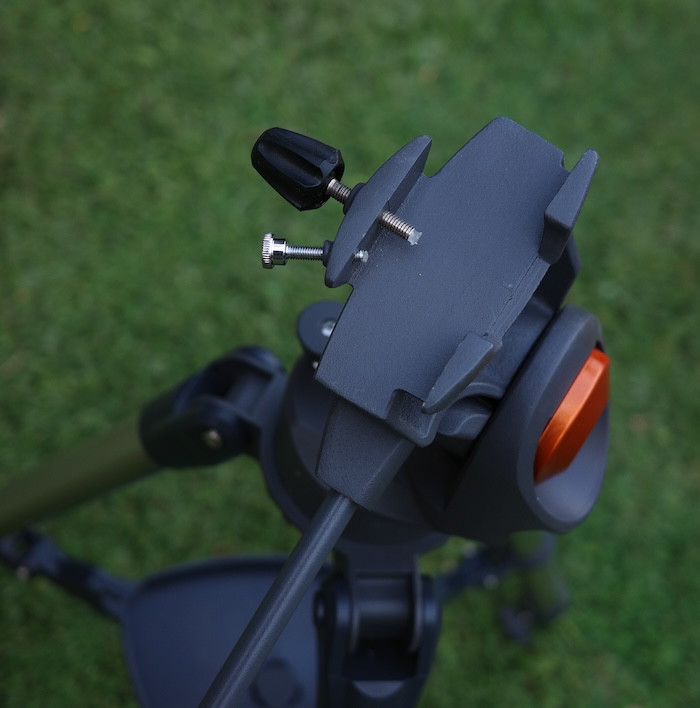The Optics
The Celestron AstroMaster 70 is a 70mm f/12 achromatic refractor using a standard Fraunhofer configuration with a crown and flint glasses for the objective lens. The long f/12 focal ratio means that there is little in the way of chromatic aberration (false color), although it is not at the near-zero that a 60mm f/15 refractor provides.
The Optical Tube Attachments

- The scope, as I see it, has an ample-length dew shield, which also serves as a light shield to boost contrast. But I also have to add that it isn’t really painted a good flat black on the inside.
- The AstroMaster 70 has a 1.25” rack and pinion focuser, which is mostly plastic. I tried, and it’s working well.
- The red-dot finder is attached to the left side of the focuser and is, in my observations, more than adequate for a small scope such as a 70mm refractor.
My main complaint about the optical tube is that, like most of the AstroMaster scopes, I can’t balance the 70AZ if it has anything remotely heavy on the focuser. The Vixen-style dovetail plate that attaches to the mount is far too short to slide it for balancing, and the scope has no tube rings; the dovetail is directly attached via some screws in the mount that acts as the Vixen saddle, as seen below.

Decent Eyepieces & Accessories
The AstroMaster 70 comes with two surprisingly decent Kellner eyepieces—20mm and 10mm—giving 45x and 90x magnification, respectively. However, as I’ve always held, 45x is a little much for low power with a 70mm telescope. A 25mm or 32mm eyepiece would be better.
Mediocre Diagonal

The Celestron AstroMaster 70 comes with a cheap, mostly-plastic Amici diagonal designed to be used for terrestrial viewing.
The Amici prism produces a bright spike on bright stars and planets and isn’t very high quality. However, a proper diagonal would cost nearly half the price of the telescope, and Celestron does bill this scope for terrestrial viewing, so I’ll give it a pass.
If you’re wondering about the odd shape of the diagonal and the strange grip that seems to be built in, it’s because Celestron has figured out that people tend to grab the diagonal and use it as a handle. It’s clear to me that they designed it accordingly to be a little more suitable for that function.
Decent Finder, But With Problems
For a finder, the AstroMaster telescopes have a decent-quality red-dot finder with a really low-quality plastic bracket attached. These are actually retrofits. The telescopes originally included very low-quality plastic sights that were eventually removed. Due to the nature of the ad-hoc plastic bracket, the included finder is difficult for me to actually align with the telescope, making aiming the 70AZ (or indeed, any AstroMaster telescope) rather frustrating, if not nearly impossible.
AstroMaster 70’s Mount/Tripod Performance

The AstroMaster 70’s mount strikes me as basically a glorified camera tripod, although not with a fluid head (thank goodness—it would be impossible to use if there were such a thing). There is a panhandle, and there are simple locks/clutches for both the altitude and azimuth axes.
This works fine with a shorter 70mm telescope, but I can see this mount configuration presenting two problems with such a long refractor.
For one, the scope will only be balanced at certain altitude angles. The rest of the time, I have to tighten down the altitude lock. Ever wonder why the more expensive alt-az mounted scopes have those weird angled sides? It’s to keep the center of mass of the tube at the center of torque of the mount. The AstroMaster 70’s mount doesn’t do this. The effect is exaggerated by the long tube, which provides a longer moment arm and thus a greater difference in torque depending on how high the scope is pointed.
Second, without slow-motion controls, I’ll be struggling to keep objects centered or even in the field of view at all when tracking at high power. This isn’t helped by the fact that the tripod isn’t the most stable (the legs are quite thin), though it works well enough for the price.
Alternative Recommendations
I’d recommend quite a few alternatives to the AstroMaster 70AZ:
- The Celestron FirstScope is way cheaper than the AstroMaster 70AZ but suffers from poor-quality optics. However, it is still easy to aim and comes with a stable mount and good accessories.
What can you see with the Celestron AstroMaster 70?
If we can get over the mount issues, the AstroMaster 70 shows Mercury and Venus’ phases, a wealth of detail on the Moon, Jupiter’s cloud belts, moons, and maybe the Great Red Spot, Saturn’s rings and the Cassini division in them (the latter requiring good seeing), as well as its moon Titan and possibly a few other moons such as Rhea and Dione. Uranus and Neptune, if we can even find them in the first place, are tiny bluish dots that will be difficult to distinguish from stars.
Outside the solar system, the 70mm aperture limits me to a handful of deep-sky objects such as the Orion Nebula, some open clusters such as the Double Cluster and M35, and the Ring Nebula. There are also countless double stars to explore if you’re into that. Otherwise, that’s it. The scope is simply too small to show us a lot of deep-sky objects.




My son received 2 telescopes for Xmas. The gskyer 70400 I believe and Celestron astromaster lt 70 az telescopes. Which one do you recommend keeping. Or do you recommend returning both and getting something else? Thank you!
I would return both and get a Dobsonian if possible.